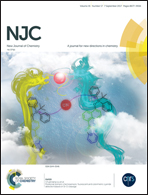Renewable resource derived aliphatic hyperbranched polyurethane/aluminium hydroxide–reduced graphene oxide nanocomposites as robust, thermostable material with multi-stimuli responsive shape memory features†
Abstract
An eco-friendly, high performance renewable resource derived aliphatic hyperbranched polyurethane nanocomposite was developed with an aluminium hydroxide–reduced graphene oxide nanohybrid by an in situ fabrication technique. The aluminium hydroxide–reduced graphene oxide nanohybrid was prepared by a facile route. The prepared nanohybrid and nanocomposites were characterized by using different spectroscopic and analytical techniques. Various properties of the nanocomposites were evaluated. The nanocomposites exhibited remarkable enhancement in tensile strength (350%), elongation at break (292%) and toughness (441%), in comparison with the pristine polymer. The developed system showed high thermal stability (initial degradation temperatures up to 315 °C). The nanocomposites also demonstrated excellent multi-stimuli triggered shape memory attributes under thermal energy (60 °C), microwaves (300 W), and sunlight (105 lux). Both the polymer matrix and the nanohybrid contributed to the overall performance of the nanocomposite. The performance of the nanocomposite was found to be dose-dependent on the nanomaterial loading. Thus, development of such multi-faceted materials holds promise for advanced applications.



 Please wait while we load your content...
Please wait while we load your content...